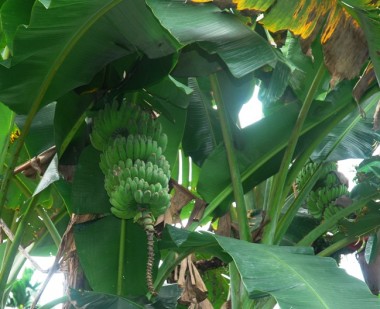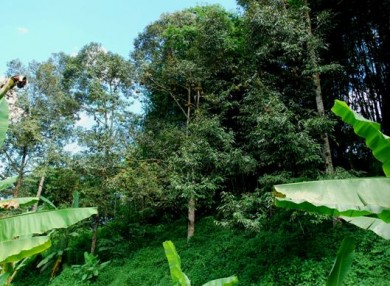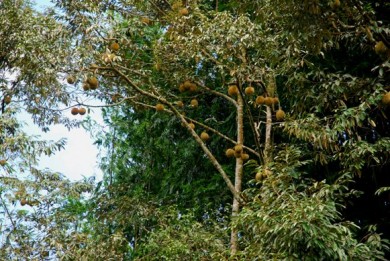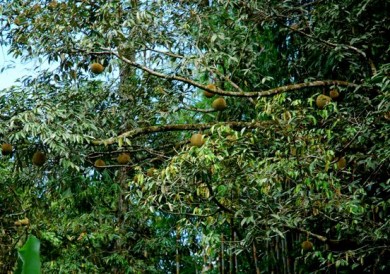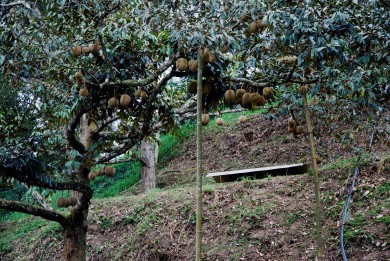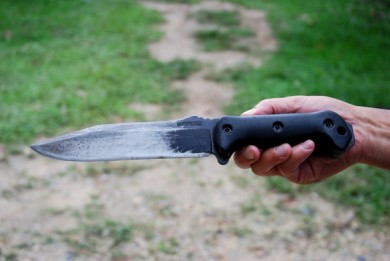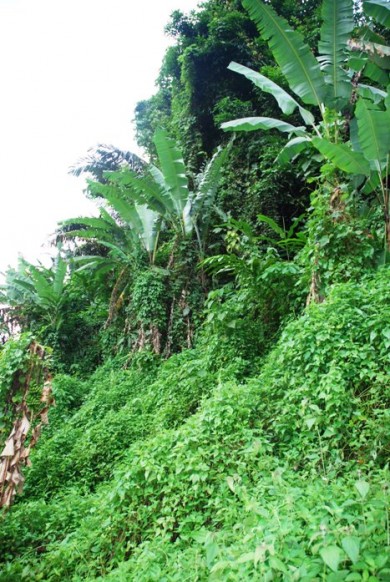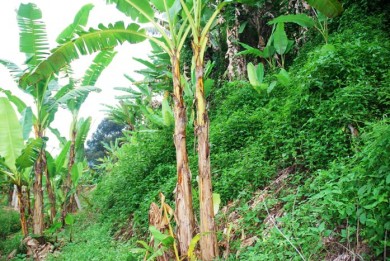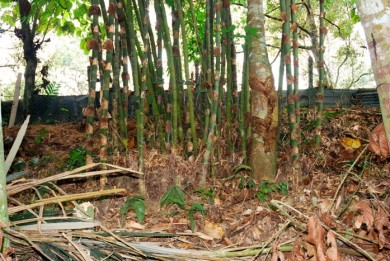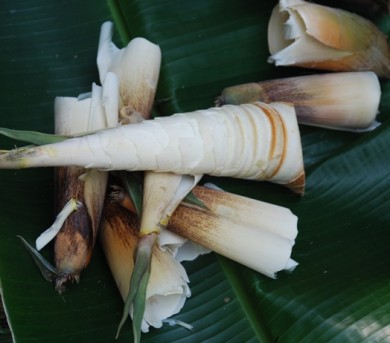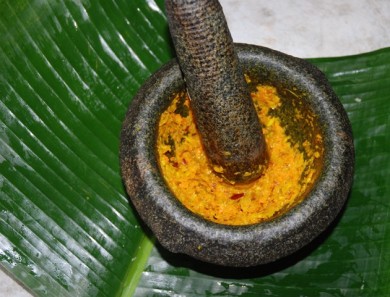Jul 04, 2017
Today at the Wild Farming Pilot #wildfarming
'Wild Farming' is a work-in-progress to mimic nature. On a vegetable plot, we will plant maybe 40% non-market plants, some with insect repellent properties, some that are just aromatic to confuse insects, etc., and 60% a mix of, or a variety of, market vegetables and plants. In our pilot plot here, the market vegetables are ridge gourd, brinjal, bird's eye chili, sweet corn and lady's fingers.
We are expecting some sweet corn next week; "GMO free some more" ![]()
Chilies should be plentiful next couple of weeks. Lady's fingers have started to produce. The terung has slowed a bit but we shall fix that with a compost dressing this couple of days. Over at the petola section, they are working overtime!
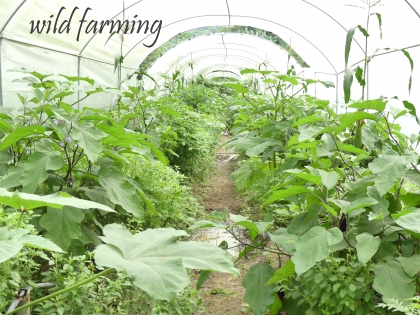
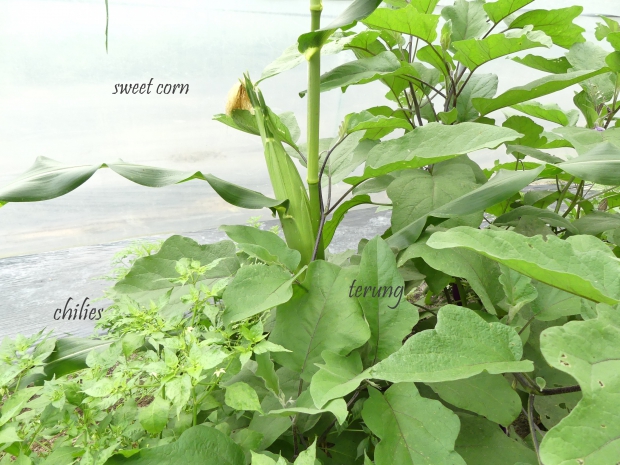

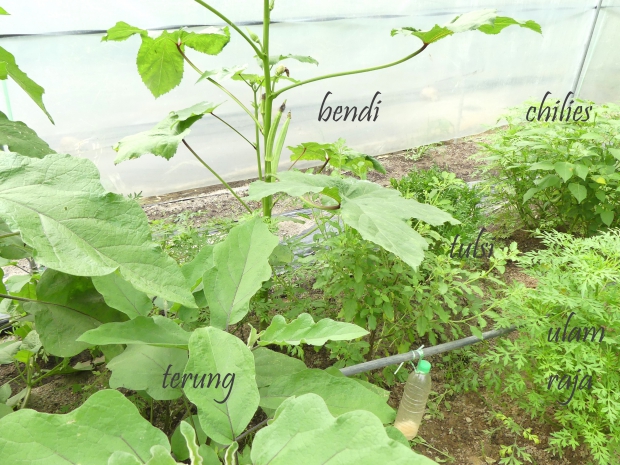
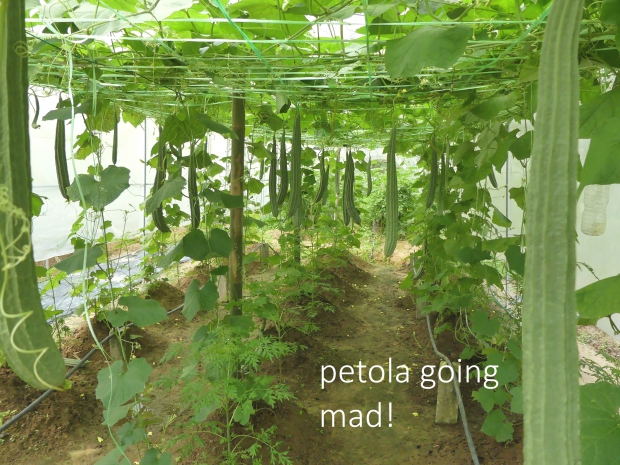
14:26 Posted in Nature Farming, Permaculture, Sustainable Farming, Wild Farming | Permalink | Comments (0) | Tags: wild farming, sustainable agriculture, organic farming
Apr 16, 2013
Free-Range Egg Model for Rural Farmers
This is the free-range layer model we intend to implement as a social enterprise with rural low-income farmers. If they sell the eggs themselves at the Farmers’ Market, each egg should fetch rm1.00 each. We will supply them 200 pullets that are close to laying unlike what is happening now when the poor farmers are given day-olds and in no time, disease will wipe out all the birds.
At the very least, the farmers can expect an income of between rm2500 to rm3000.00 per month.
We will be starting with five farmers in Pahang.
13:50 Posted in Blog, Chickens, Nature Farming, Permaculture, Sustainable Farming | Permalink | Comments (1) | Tags: free range egg laying model, free range eggs malaysia, organic eggs malaysia
Apr 15, 2013
Sights And Sounds Of The Farm - Emerald Doves
Emerald Doves are usually very flighty and nervous near humans due to poaching. At our farm, they are resident and are found in many nooks and corners. Many times they will just swagger off, in a pigeony way (which they are) when they see us. Here's one that's just in front of our workers' quarters. The video of it feeding in our garden captures the sounds of the farm at around 11 am, mid-morning. If we hadn't tell you, you would think the video is in the forest with the myriad sounds of birds and insects. But that's what we are trying to achieve in our farming - that we can be commercial and yet be in harmony with Nature.
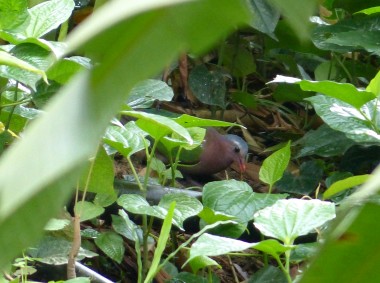
Here's a recording of the sounds that you will hear at our farm. You would be forgiven if you think you are in the jungle.
16:12 Posted in Blog, Permaculture, Sustainable Farming | Permalink | Comments (0) | Tags: emerald dove, nature farming, permaculture, sounds of tropical forest, punai tanah
Mar 15, 2013
The Yellow Birdwing, Troides helena, is now a resident
On the 1st day of this year we saw for the first time a single female Yellow Birdwing, Troides helena, flying fast at the perimeter of our farm, as if making an aerial survey.

From a distance, it looks like a bird
The Yellow Birdwing is protected by law and is becoming difficult to see in the wild due to loss of habitat and due to collectors.
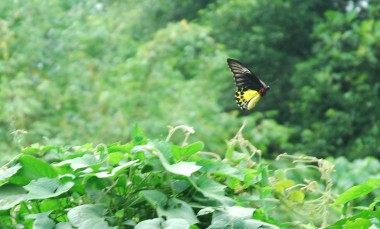
The female zooming past us on the 1st of January, 2013
Just barely 2 1/2 months later, they have made our farm their home. They are breeding and have become a familier sight. And interestingly, they show no fear of us. Also of interest to us is the fact that the farm has a larger share of birds than other places and yet they choose to breed here.
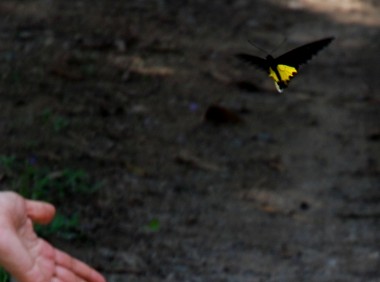
They show no fear of us
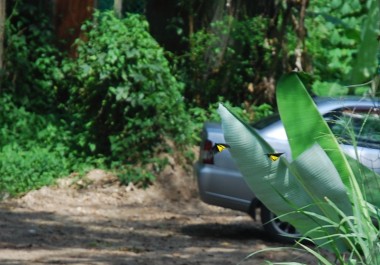
You won't find wild birdwings flying around your cars!
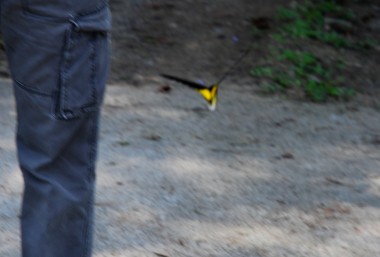
Flying close to us without fear.
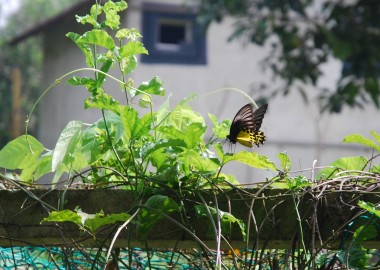
We leave fruits to ripen on the trees for birds and butterflies. Our workers are instructed not to feed nor to disturb nor to stare at the birds, and also the butterflies. We make as if they are non-existent. We plant their larval plants and we plant flowering vines that will bloom up in the canopy for the butterflies. And above all, no poison, no chemicals. We co-exists, and they so enrich our lives as farmers.
18:18 Posted in Blog, Nature Farming, Permaculture, Sustainable Farming | Permalink | Comments (0) | Tags: common yellow birdwing butterfly, troides helena, rare butterflies
Sep 01, 2012
Animal Feedstock - localise it
There is this mental block that we have to have corn for animal feed. So Malaysia try to grow corn for feed but it did not work out too well - not if you are competing with heavily subsidised imported corn. Further, corn and soya are termed 'commodities', ie it means people are allowed to speculate on its future price. For farmers that means your future is influenced by speculators. For small countries like Malaysia, that means our food security is in the hands of big spending speculators. Hey, that's not a comfortable position to be in, and really I often wonder why we allow ourselves to be dragged into such a precarious position.
So, recently due to droughts in USA, speculators have jumped in and the price of corn and soya has gone through the roof. Farmers are dying because suddenly more cash is needed, practically overnight, to feed the animals. Consumers are shouting because suddenly meats are more expensive.
One of the ways local small farms can get off the carousel is to grow feedstock that is indigenous to local climate and which require as little input as possible.
At our farm, we use cooking bananas. All imported feedstock corn is GMO. Our bananas are not.
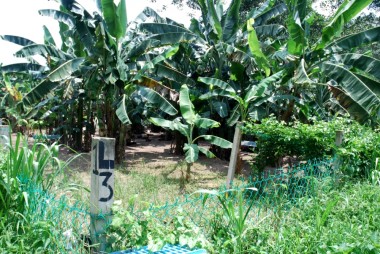
All our chicken fields are planted with these bananas
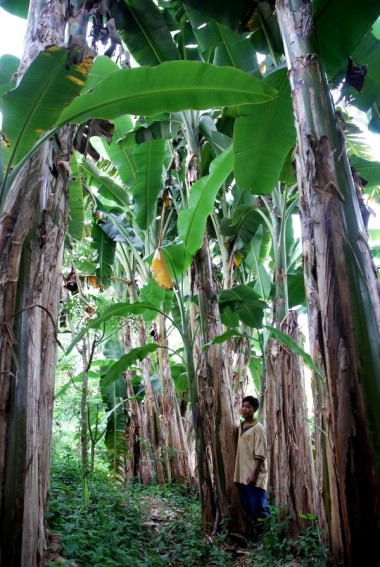
They are tall trees, up to 25ft, with large shade areas. The fruits are higher in energy values than corn.
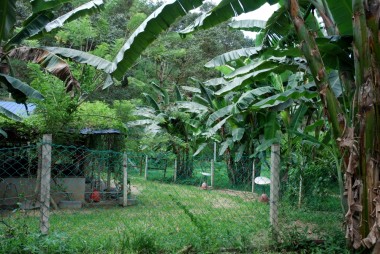
Because of their height and large shade area, we plant them to block off west-side sun, thus saving on artificial cooling costs.

They also play an ecological role by absorbing nutrients from waste water since they are water-resistant.
They produce more feedstock per acre of land than corn.
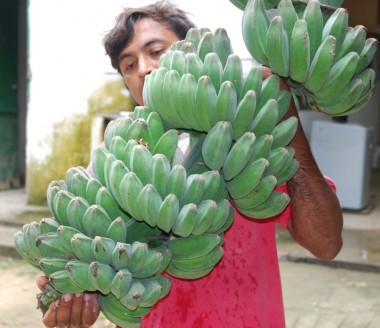
Each bunch is about 20 to 30kg
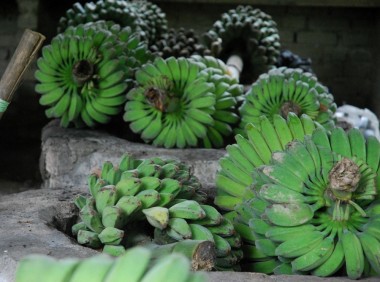
They store well, and can be readied for feedstock in a jiffy
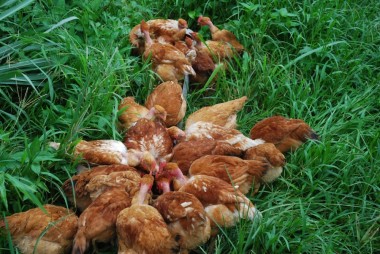
Chickens love the bananas and make a mad rush for them when presented.
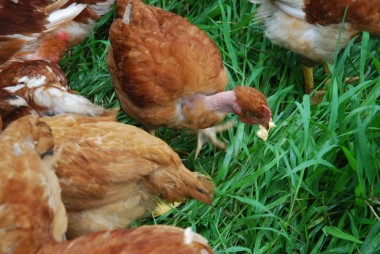
Bananas do not have the high omega 6 that corn has and thus produce a healthier meat for human consumption. Corn not only have high omega 6 but also is practically 100% GMO now.
10:31 Posted in Blog, Permaculture, Sustainable Farming | Permalink | Comments (0) | Tags: feedstock, increasing food costs, corn, soya bean, drought, cooking banana, bbb musa, local feed ingredients
Jul 22, 2012
Forest In A Farm
Twenty years ago, we started to plant forest trees in a zone within the farm. Today, some of the trees are 100 feet tall, and of course, still growing. We plan now to develop this zone into an area of bio-diversity and hopefully, some of the animal life driven off by logging uphill, will instead make this zone their home. The forest uphill was home to siamang, wild cats, and many more.
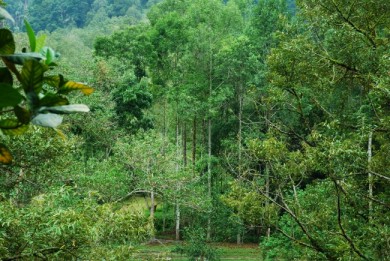
Canopy trees in a farm!
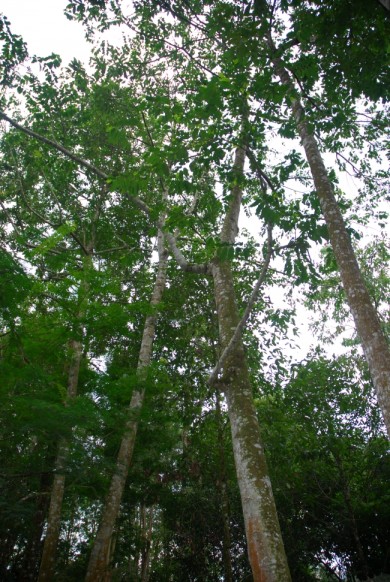
Meranti
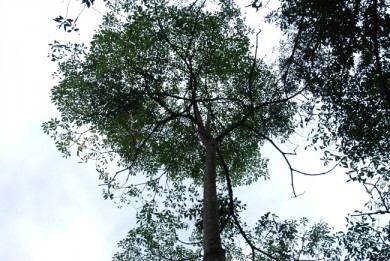
Pulai
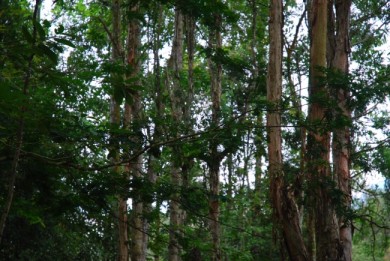
Gelam

Kasai
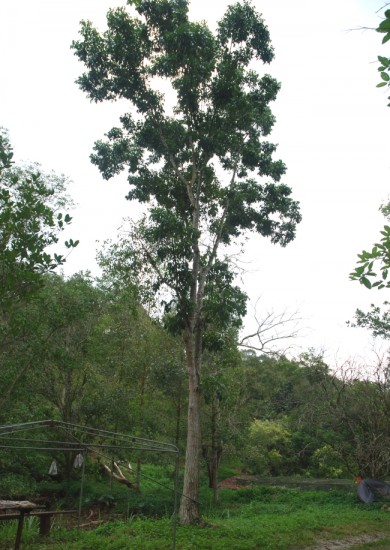
Mahagony
Sustainable agriculture is long term, planning decades ahead, not months or weeks.

At one end of the zone is this beautiful location, perhaps a suitable site for a Sustainable Agricullture Institute.
08:02 Posted in Blog, Permaculture, Sustainable Farming | Permalink | Comments (0) | Tags: agro forestry, permaculture, meranti, nyatoh, pulai, rain trees
Nov 19, 2011
Durians - Organically, Sustainably.
Durians are in season at our farm.
The trees are laden with fruits.
Branches need to be supported or else they will break from the load.
There's zero purchased inputs into our more than 800 trees.
We ferment discarded organs amd innards from our chicken operations to provide nitrogen for the trees.
We spray compost tea made from humus (from our compost) once a week to keep fungus and insects at bay.
That's it folks, plus of course integrated pest management without chemical pesticides. Resulting in the only certified organic durians in Malaysia.
10:34 Posted in Blog, Permaculture, Sustainable Farming | Permalink | Comments (1) | Tags: durians, organic durian, sustainable durian farm, organic durian farm
Oct 18, 2011
A Good Knife Is Also Permaculture?
Got this knife in the late 90's for less than USD30. Around RM70.00 then, if memory serves me right.
It is a Camillus Becker Knife & Tool, BK 7, made with high carbon 0170-6C steel.
This original version, in mint condition sells for USD185 on ebay today.
The current version by Ka-Bar sells for around USD65 on ebay. There're some reviews that compare it somewhat negatively against the original version. However, on youtube (type kabar BK 7) there are a lot of guys who love the Ka-Bar version.
You can see that our knife has been well used; the powder-coated black color on the blade is almost gone.
A full tang knife is balanced around the middle of the knife and is good for work like removing the rim of a tire. It is also good for close quarter combat where a stabbing motion is used. For that reason, apparently many American soldiers in Iraq bring along a BK 7. A half tang such as our typical 'parang' is blade-heavy and is good for slashing work. Removing a rim with a blade-heavy knife does not allow you to use your body weight and hence you will tire after just a few tires.
Santa, our worker from Nepal takes a casual 30 secs to remove the rim of this used tire using the BK 7:
Santa moves the knife outwards in the video. That's not the preferred method as it is relying on the sharpness of the blade and an unnatural positioning which will strain the arm muscles. I think Santa woke up on the wrong side of the bed.
I prefer an inward moving knife which allows me to use my body weight in an up-down movement and my arm muscle do not cramp up after an hour or so of such work since it is my back muscle and my weight that's doing the work, not the arm.
Knives that are made well, such as the BK 7, demonstrates the principles of permaculture in manufacturing: making things well, using minimal material, and to last a lifetime.
18:11 Posted in Blog, Permaculture | Permalink | Comments (0) | Tags: camillus bk 7, becker knife & tool, permaculture in manufacturing, good knife, survival knife, good combat knife, used tire, removing the rim of an used tire
Oct 14, 2011
Slope Farming I
Land is getting scarce and sometimes we have to work on very steep slopes.
Accessibility and erosion then become major concerns.
Using used tires to make stairways is one way to create permanent, stable access with minimal erosion.
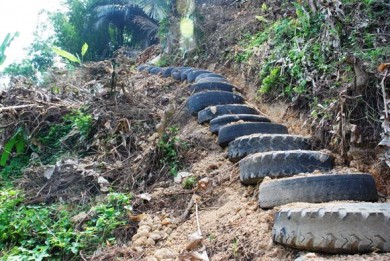
The top rim of the tire should be removed (using a full tang, heavy survival knife is best for this job). Earth used to fill the tires should then be compacted.
This stairway has been holding itself very well with no erosion or stability problems through two monsoon seasons now.
12:35 Posted in Permaculture, Sustainable Farming | Permalink | Comments (1) | Tags: uses for used tires, tire gardening, tire stairs, permaculture, sustainable agriculture
Sep 14, 2011
The Earth Provides…
At the farm, we leave many of the original plants alone. And as you walk, you will find food almost everywhere – bamboos, banana piths, banana hearts and more.
Here's a clump of bamboo in our farm, which we can see growing wild alongside highways, in secondary forests, along village trails:
Here's some shoots we cut off from just such a clump.
Remove the outer bark and cut into thin slices.
Soak overnight, then replace the water with new water and bring to a boil. These steps will reduce or eliminate the bitter taste of the shoots.
Throw away the water and it is ready for making a gourmet dish.
Here are the main ingredients –
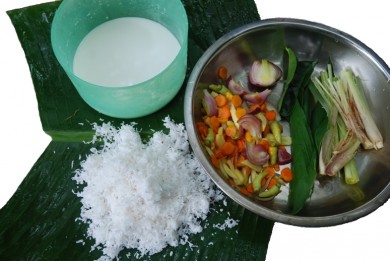
Turmeric, small onions (shallots), garlic, chillies, pound them together.
Make coconut milk from grated coconut meat.
Add serai (lemongrass), turmeric leaves and limau purut (kaffir lime) leaves and the pounded ingredients.
Put all the ingredients in the milk together and bring to a boil. Then add the bamboo shoot slices and prawns, salt and traditionally, some sugar, to taste.
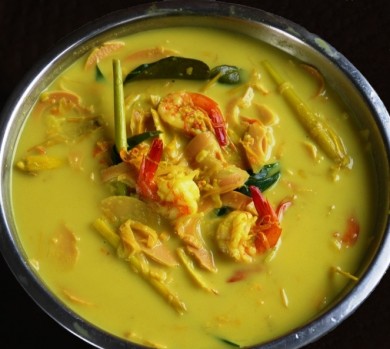
Seriously yummy; the crunchiness of the shoots offset the tender prawns to make a delicious texture-filled, aromatic dish.
18:11 Posted in Blog, Permaculture, Slow Food / Rare Receipes | Permalink | Comments (0) | Tags: rebung masak lemak, bamboo shoots, slow food








